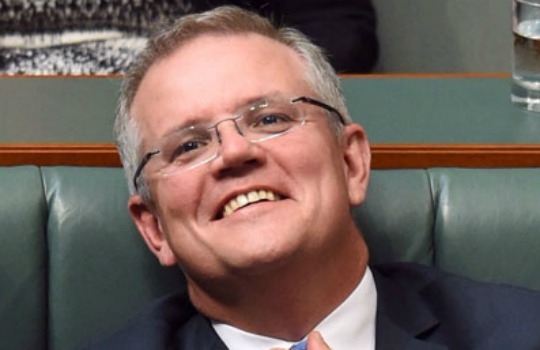
Canberra weighs in behind ICT innovation and “ideas boom” under the federal budget unveiled by Treasurer Scott Morrison.
The Australian government is weighing in behind the “ideas boom” and ICT innovation under the federal budget hande down by Treasurer Scott Morrison. This budget reinforces support for the administration’s high-profile $1.1 billion National Innovation and Science Agenda.
Among the 2 July election commitments, the National Innovation and Science Agenda will continue encouraging entrepreneurs to innovate. This supports collaboration and access to capital, including tax incentives, crowd-sourcing, and an expanded use of Blockchain.
The tax incentives are available for investments involving early stage innovation companies. This encourages collaborative research, while attracting new talent from overseas and locally. Moves are underway to remove unnecessary regulation.
Future digital marketplace
The flagship Digital Transformation Office receives $18.8 million over five years to create a “Digital Marketplace.” This marketplace makes it easier for small and medium enterprises and start-ups to deliver digital services to government, while building the innovator and entrepreneur base. The administration is developing a Digital Marketplace for businesses to compete for government information and communications technology (ICT) work. Large scale ICT projects will be broken into individual components to allow more innovative solutions.
On the innovation front, Data61 – the merger of National ICT Australia and CSIRO’s digital research unit – is creating Australia’s largest data innovation group. This entity will develop cutting edge technology, while improving the industry’s cyber security capabilities.
Blockchain for government and industry
Blockchain, or distributed ledger technology, has the potential to revolutionise transactions. Data61, part of CSIRO, is reviewing opportunities to apply Blockchain across government and the private sector. This incorporates concurrent pilot testing in areas such as sharable registry information and verifiable supply chains.
Canberra has released a consultation paper on changing the GST treatment of digital currencies. This change ensures that consumers are no longer ‘double-taxed’ when using digital currencies to buy goods and services already subject to GST.
On the eInvoicing, front, a new study will weigh the costs and benefits of electronic invoicing by agencies. This eInvoicing may improve efficiency by 60 to 80 per cent with annual savings to the economy of up to $10 billion, according to official estimates.
Outlook for Fintech
Supporting FinTech remains central to the government’s innovation future. “Global disruption in financial services is changing the way the world does business. Australia must keep pace with innovation to stay competitive.”
Financial technology is changing how businesses and consumers interact, while fast-tracking the introduction of new products and services. The Government’s FinTech Statement offers the roadmap to build a strong and vibrant industry. This week’s budget announces several initiatives to drive expansion of Australia’s financial services exports across the Asia-Pacific region.
“Regulatory sandbox”
Australia’s FinTech industry is gaining prominence: nine local companies were listed amongst the leading global FinTech innovators in 2015. The administration says the financial system can support a ‘regulatory sandbox.’ This is where FinTech businesses can test their ideas and business models.
The Australian Securities and Investments Commission will shortly release a consultation paper on a regulatory sandbox exemption. This enables entrepreneurs to test ideas for up to six months. This policy factors in a limited number of retail clients and prescribed investment thresholds. Certain consumer protections are being maintained.
Stake in start-ups
Employee Share Schemes enable staff to share in the success of a business from the early stages. This is being fast-tracked by providing an option to acquire shares in the company. Recent reforms make these schemes more “user-friendly” by reducing the disclosure requirements.
There is endorsement for crowd–sourced equity funding. This expands financing options for innovative businesses, while enabling funds to be raised from a large number of small investors.
Improving bankruptcy and insolvency laws seek to reduce the stigma associated with failure and foster enterprise innovation. This strikes a better balance between encouraging entrepreneurship and protecting creditors.
Moves are underway to increase access to company losses by improving the tax system. This means that entrepreneurs or loss-making start-ups are encouraged to remain agile, while seeking opportunities to innovate and grow.
Among the big ticket spending items:
•$230 million is earmarked for the cyber security strategy; of this, $122 million is reallocated from Defence.
•$199.4 million is shared between the Department of Education, the Department of Human Services and the Department of Social Services. This is to build a new IT system to process payments that support a revised families package support scheme.
•$178.3 million for the Department of Health to integrate existing state and territory-based registers.
•Over 5 years, $50.5 million to support the MyGov site. This includes $5.4 million for a joint team that brings together the Department of Human Services, DTO, Treasury and Department of Prime Minister and Cabinet.
Other funded projects include:
•$39.2 million to improve regulatory and management systems at the Australian Securities and Investments Commission.
•$32.6 million for a second phase of the Australian Federal Police’s transition to a new data centre.
•$15.4 million for a first phase of the AFP’s radio communications replacement.
•$24.8 million to fund a business case that replaces a legacy core IT systems at the Department of Veteran’s Affairs.
•$23.9 million for the Department of Veteran’s Affairs to run an existing systems.
•Over 3 years, $28.9 million to top up CrimTrac’s $50.2 million project that involves a biometrics identification services (BIS) system. This replaces an existing national automated fingerprint identification system.
•$15.9 million over four years to build new data analytics capability at the Department of Agriculture and Water Resources, and to build data involving on biosecurity risks.
•$12.4 million to upgrade IT systems across various agencies to create a more transparent reporting scheme for limited tendering processes.
•$9.9 million to fund CrimTrac’s build of a national domestic violence order sharing system, which will allow the orders to be more effectively enforced across state and territory borders.





